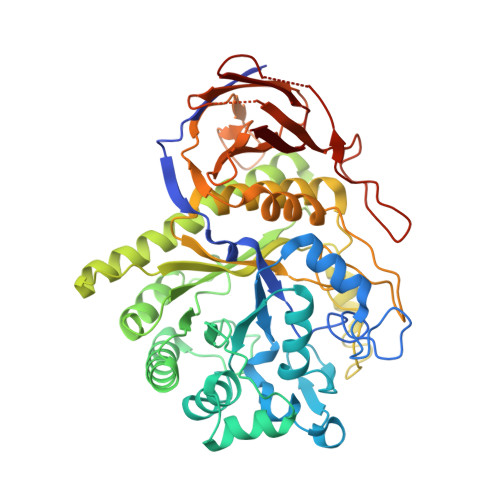Structural Insight Into the Ligand Specificity of a Thermostable Family 51 Arabinofuranosidase, Araf51, from Clostridium Thermocellum.
Taylor, E.J., Smith, N.L., Turkenburg, J.P., D'Souza, S., Gilbert, H.J., Davies, G.J.(2006) Biochem J 395: 31
- PubMed: 16336192
- DOI: https://doi.org/10.1042/BJ20051780
- Primary Citation of Related Structures:
2C7F, 2C8N - PubMed Abstract:
The digestion of the plant cell wall requires the concerted action of a diverse repertoire of enzyme activities. An important component of these hydrolase consortia are arabinofuranosidases, which release L-arabinofuranose moieties from a range of plant structural polysaccharides. The anaerobic bacterium Clostridium thermocellum, a highly efficient plant cell wall degrader, possesses a single alpha-L-arabinofuranosidase (EC 3.2.1.55), CtAraf51A, located in GH51 (glycoside hydrolase family 51). The crystal structure of the enzyme has been solved in native form and in 'Michaelis' complexes with both alpha-1,5-linked arabinotriose and alpha-1,3 arabinoxylobiose, both forming a hexamer in the asymmetric unit. Kinetic studies reveal that CtAraf51A, in contrast with well-characterized GH51 enzymes including the Cellvibrio japonicus enzyme [Beylot, McKie, Voragen, Doeswijk-Voragen and Gilbert (2001) Biochem. J. 358, 607-614], catalyses the hydrolysis of alpha-1,5-linked arabino-oligosaccharides and the alpha-1,3 arabinosyl side chain decorations of xylan with equal efficiency. The paucity of direct hydrogen bonds with the aglycone moiety and the flexible conformation adopted by Trp(178), which stacks against the sugar at the +1 subsite, provide a structural explanation for the plasticity in substrate specificity displayed by the clostridial arabinofuranosidase.
Organizational Affiliation:
York Structural Biology Laboratory, Department of Chemistry, University of York, York YO10 5YW, UK.

















